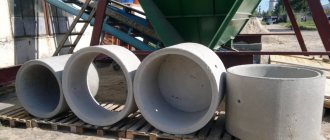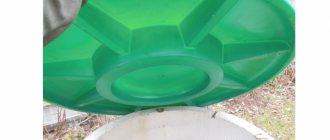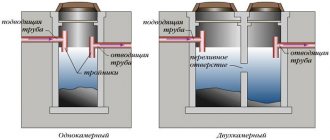How much septic tank volume is needed for a family of 3 people?
The volume of a septic tank for three people is calculated as follows: 3 * 200 * 3/1000 = 1.8 cubic meters. For the calculation, the average water consumption was taken. Based on the calculations, it can be seen that a family of three with an average water consumption per resident requires a two-chamber septic tank.
Interesting materials:
What interacts with sulfur dioxide? What to take with you when moving away from your parents? What kind of fable is it that even an eye can see and a tooth can be numb? What kind of movie woke up after 12 years of coma? What kind of qiwi wallet? What is that red dot in the egg? What kind of crop is sweet potato? What kind of fur is Striga? What kind of Forge mod is this? What is the XRay Engine error?
How to calculate the cubic capacity of a round pit
Volume is a quantitative characteristic of the space occupied by a body, structure or substance.
Volume calculation formula:
A – length; B – width; C – height.
You can quickly perform this simple mathematical operation using our online program. To do this, enter the initial value in the appropriate field and click the button.
In our design organization you can order a pit volume calculation based on a technological or design specification.
This page presents the simplest online calculator for calculating the volume of a pit. With this one-click calculator you can calculate the volume of a hole if the length, width and height are known.
Using a calculator
, you can find out not only the volume of the well, but also the cost of all work. To do this, you will need to maintain predicted dimensions
and the calculator will automatically display the result.
Of course, you can do the calculations yourself using formulas
, but this will take time.
As is known, to calculate the volume
, it is necessary to multiply the length, width and height, the formula is used
:
Volume=L*W*H
If you need to find out the volume of a
cylinder
, you will need to use
the formula
:
For example, you need to find the volume of a well
, where: Diameter – 1.5 m
;
Depth – 10m
.
We are looking for the radius, for this we divide the diameter by 2
, respectively, the radius will be equal to
0.75 m (1.5/2)
.
Next, using the formula, we proceed to calculations: (3.14)*0.75²*10 = (3.14)*0.5625*10 = 17.66
From this it follows that the volume of the well will be equal to
17.66 m³
.
Main difficulties
The main errors that arise during calculations are:
- Unwillingness to stick to the project plan.
- Refusal to add soil freezing level indicator to the formula.
- Lack of desire to double-check during the digging process.
There are builders who take measurements “by eye”, relying on their experience, so engineers recommend double-checking the compliance of the foundation marking numbers with the numbers indicated in the plan 2-3 times. This will help to avoid difficulties during the construction process when laying the foundation and future communications.
The main difficulty in calculating the size and volume of trenches is also the lack of desk processing. Despite the fact that it is carried out by experienced specialists, even they make errors in the calculations. Here it is important to correctly make geodetic measurements based on the primary topographic survey.
There is no need to skimp on marks, and proper fixation of such dimensions as the top and bottom of the trench, the height of the slopes, and marks inside the pit is required. A correct counting system must necessarily correspond to the truth. Fictitious measurements will be a huge construction mistake and will cause problems in the future.
Camera data should be processed as quickly as possible , as they can be erased and lost. It is necessary to record the obtained result. Inconsistencies in measurements must be rechecked several times. When shooting, attention is paid to protruding reference points.
To avoid errors in calculations, you need to plan the construction of the recess horizontally. If the calculation is very complex, you need to double-check it several times.
If a construction company works with professionals, then you should not bother with the cartogram and pivot table. The specialist will take measurements not only using a topographic survey, but also manually, using special construction tools.
How to set up a calculator so it doesn't round
Rounding a value up or down on a computing device is done using the built-in switch or the TAB key.
The indicator can be set on the switch in five positions A 0 2 4 F. These designations determine the number of decimal places, which is very convenient for calculations:
- A is an automatic comma. In this mode, a decimal point automatically separates the last two digits entered.
- The values 0, 2, 4 set by the indicator determine the number of decimal places, respectively 0 digits, two digits or four.
- F is floating point, which turns off the rounding mode.
Microcalculators also provide three rounding modes:
- The up arrow key resets all numbers to the first significant digit of the indicator and adds one.
- The down arrow key does not round the resulting values.
- The 4/5 key allows you to work with rational expressions.
In this way, you can control the process of rounding a value: round it up or down, or turn it off completely, depending on the task at hand.
How to care for a well on your property?
Whatever method of strengthening the walls is chosen, the well needs to be cleaned and disinfected from time to time. Cleaning must be done at least once a year, and if foreign objects regularly get into the well, then at least twice a year.
To clean a well, all the water is pumped out of it using pumping equipment, then a person in special equipment goes down and carries out all the required cleaning procedures. After sand, dirt, silt and foreign objects are removed from the walls and bottom of the well and raised up, disinfection work is carried out. To do this, the inner surface of the walls of the recess is sprayed with a chlorine solution using a special brush or an ordinary broom.
When the water fills the well again, you also need to pour a chlorine solution into it at the rate of 150 mg per 1 liter of liquid. Here you will also need to know the volume of your well. Once the chlorine solution is mixed with the liquid, the well is closed with a lid and left for a couple of hours. Then the water is pumped out again. If, after filling the well with water, you still smell the acrid smell of chlorine, then the procedure for pumping out the water will have to be repeated.
Element strength
The strength of a reinforced concrete sewer well is quite sufficient for trouble-free use for decades.
Although the resistance of concrete to compression and expansion loads is 10 times lower than that of high-quality steel, the reinforcing jacket does not allow the product to collapse, taking on most of the deforming force.
The advantages and disadvantages of a reinforced concrete well are directly related to the material of manufacture:
- reinforced concrete is technologically advanced and cheap. A part of any complexity can be cast in a mold without unnecessary problems;
- reinforced concrete is not subject to corrosion. The walls of the well are smooth and easy to clean;
- the well material is inert and does not affect the quality of water (the case of use as a source);
- ready-made elements significantly simplify work and increase installation speed.
Among the disadvantages, one can note the low resistance to impact and deformation loads. But in the case of constructing a well, this practically does not matter.
What does the water level depend on?
The filling capacity of a structure is influenced by many factors.
This is its depth, the thickness of the aquifer, seasonal weather conditions, etc. It is also important how water enters the well - depending on this, key, storage and river types of such structures are distinguished
Types of wells
So:
The water comes into the springs as fountains gushing out from the bottom - you can see them if you pump out all the water from the mine. Their flow rate is small; after complete pumping, it takes from several hours to several days to reach the previous level (2-3 rings). The most common are storage tanks - the water level in them reaches from 4 to 10 rings and higher, depending on the thickness of the aquifer and the depth of immersion in it. But it also takes a long time to fill, 5-10 days. This is due to the lack of internal pressure in the water vein. Filling with water occurs through holes in its walls.
The depth of the river depends on the depth of the underground river bed and can reach 30 meters. With a sufficiently large influx of water in a free flow, its level usually does not exceed one and a half meters. But it practically does not change no matter how much water you pump out. Special mention should be made of artesian wells that supply water from deep calcareous layers
The water in them is sandwiched between two waterproof layers and is therefore under pressure. Its level is always sufficient, it does not decrease, which is very important in the absence of other sources. But the price of such a structure is very high and its construction is not always economically profitable.
Photo of a dry well
Without preliminary geological exploration, it is difficult to predict what type of well you will have, how much water it will contain, and how quickly it will recover after pumping.
External factors
If it happens that the water in the well has disappeared (see: Water has left the well - what to do to restore it) or it has become significantly less, you need to find out the reason in order to understand whether it can be returned. The reasons can be very different:
- Seasonal level fluctuations. Filling capacity depends primarily on replenishment of groundwater reserves from the outside. During heavy spring rains and snow melting, the level increases, and during summer heat and winter frosts it decreases.
- Aquifer depletion. May occur as a result of active human activity in adjacent areas. This is a large-scale construction with deep disturbance of the soil, landscape and reclamation work.
- Changing the course of an underground river, etc.
Finally, a significant decrease in flow rate may be associated with simple clogging, silting of its bottom, as a result of which water simply cannot flow into the mine in the same volume.
Advantages and disadvantages of reinforced concrete rings
Sewer rings are extremely durable and less expensive than similar drinking water products. The fact is that when choosing elements for constructing a well, you need to be interested in what kind of solution was used to coat the mold during casting. To make well rings for water, wax-based coating is usually used; it is more expensive, but such rings will not leave marks and streaks on the water. Other advantages of sewer rings include:
- high durability due to the use of high-quality concrete mixture; the service life of products can greatly exceed the warranty of 50 years;
- the rings are completely waterproof and resistant to groundwater;
- the rings contain special plasticizers that give them frost resistance properties;
- installation of rings is simple and quick;
- sewer rings are universal, they can be used for wiring communications and various pipelines, as well as for installing inspection hatches;
- ease of maintenance and cleaning is dictated by the smooth surface of the ring;
- rings are resistant to aggressive environments.
There are also some disadvantages. These primarily include heavy weight. By the way, there is no need to calculate the weight for each ring; typical sizes and the weight corresponding to them are given in a separate table. Difficult transportation and installation using lifting mechanisms also complicate the process of constructing sewer mines, and in addition, for the operation of heavy equipment, it is sometimes necessary to sacrifice a certain area of the fertile soil layer.
Types of wells
Depending on the area, you can install several types of wells:
- spring (its depth reaches 4-10 m and depends entirely on the springs gushing out from under the ground. Typically, such reservoirs take a very long time to fill - from 5 to 10 days);
- drainage (the most popular wells. Their depth is 2-3 m. They are filled within from several hours to several days. They are not highly environmentally friendly, since water is drawn from the nearest groundwater - 2-3 water layer);
- river (its depth can reach 30 m, but its filling is no higher than 1.5 m. Unlike other types, the water in river wells does not decrease, no matter how often you use it);
- artesian (water is extracted from limestone layers at a level of 20 to 200 m. Such a well is not popular, as it requires high costs).
Based on the type of building materials, wells are divided into:
- wooden (low-cost, but short-lived - it can last only 15 years in working condition. The pit is not reinforced with anything, so it can collapse at any moment. In addition, contaminated water can seep through the ground);
- brick (to build this type of well, you need a concrete foundation and wall reinforcement, as well as special bricklaying skills. Otherwise, it does not require any special costs and can be done with your own hands);
- reinforced concrete (you can pour the walls yourself or buy concrete rings. Despite the high financial costs, such a well will last a very long time).
Calculation of the volume of a sewer well
The construction of wells begins with choosing a location and calculating the volume of the well. And, perhaps, you first need to calculate the required volume, and then choose a place for the waste volume.
The volume of the sewer well directly depends on the number of people living in the house and the available bathrooms.
The volume of the well intended for sewerage directly depends on the need for water consumption. Average waste water rates per person are 150-170 liters of water per day without a bath and 230-250 liters of water per day with a bath. For an average family (two adults and two children), water consumption per day can be from 600 to 1000 liters (one cubic meter). It is generally accepted that a resorption well with a bottom area of 1 sq. m is capable of receiving and absorbing up to one cubic meter of water per day (provided that the soil is non-clayey). To ensure some reserve, the working volume of the pit is calculated as three times the daily norm, that is, for our average family of four people it is necessary to build a pit with a volume of three cubes. It must be understood that the pipe through which sewage will flow into the pit must be located at a depth of about 70 cm and the working volume of the sewer well is located below the drain pipe. It is also possible to drain the existing drainage system into the sewer pit. Its depth also does not exceed 70 cm.
Now, knowing the required volume of the sewer, we can estimate its size. The depth of the well is usually made from 2.5 to 3 meters. Subtract 70 cm lying above the drain pipe, we get a maximum working depth of 2.3 meters.
Let us remember from the school geometry course that volume is the area of the bottom multiplied by the height.
The most common are round wells, as they are more convenient to install, repair and operate.
The bottom of the well can be round (barrel wells) or in the shape of a quadrangle (square or rectangle). Of course, it is possible to make a sewer pit oval or pyramidal, but this is due to special interest in this kind of construction. We will look at the simplest and most common forms.
The area of a circle is calculated using the formula S = πR2. We find that the required volume of a well of 3 cubes is equal to the product of the height (2.3 m) by the number π (3.14) and by the square of the radius (R2).
3 m3 = 2.3 m *3.14* R2
Having carried out calculations, we find the value of R, it turns out to be equal to 0.65 meters or 65 cm, which means that the diameter of the pit should be 1.3 meters with a depth of 3 meters.
If the well is supposed to be dug not round, but square or rectangular, then remember that the area of the rectangle is the length multiplied by the width. The volume of a well is the depth multiplied by the bottom area. That is, 3 m3 = 2.3 m * bottom area.
Bottom area = 1.3 square meters. This means that either the bottom is square with a square side of 1 m 15 cm, or the bottom is rectangular with sides 1.5 m and 0.9 m. With a well depth of 3 m.
When digging a hole for a well, you must not forget that at the bottom there will be a 30-40 cm cushion of sand and crushed stone.
The sewer is dug taking into account the additional width, length and depth, which will be occupied by reinforcing walls that protect the earth from crumbling. The walls inside the well are erected as formwork and can be made of brick, concrete or reinforced concrete rings. At the bottom of the pit it will be necessary to pour a layer of sand and a layer of crushed stone with a total height of 30-40 cm to filter the absorbed wastewater
If we take into account the size of the brick in the masonry of 12 cm, it turns out that you need to dig a hole 25 cm wider (12 cm of brick width on each side) and 40 cm deeper (a layer of sand, a layer of crushed stone)
Calculations of the volume of a sewer well and a hole for it allow us to be approximate; here it is possible to round up the values of the values. According to the principle “it is better to have a well with a small supply than to have insufficient volume.”
In addition, you need to know that reinforced concrete rings are produced in standard sizes (0.7, 1, 1.5 and 2 meters - ring diameter). Therefore, having carried out calculations and found out what diameter of the well you need, we compare it with the ready-made standard dimensions of the concrete ring. Having received a calculated diameter of 1.3 meters, we choose rings with a diameter of 1.5 meters, since the industry does not produce rings with a diameter of 1.3 meters.
Classification of rings
Technical requirements must comply with the provisions of GOST 8020-90 and GOST 13015-2012. The properties of the rings are controlled according to the following parameters:
- strength, resistance to cracking, rigidity;
- waterproof and frost-resistant;
- perimeter thickness and maximum tolerance fields.
The rings must be transported and stored only in the working position.
Transporting rings
Storing in a lying state is strictly prohibited; this can cause cracks and a significant decrease in strength parameters.
Proper storage of rings in working position
Concrete rings are very rarely used as separate and completely independent elements; more often they are mounted together with other products, which ensures their optimal operation.
How are concrete rings and additional structures classified?
| Item name | Brief description of technical parameters and purpose |
| Ring | The internal diameter ranges from 1000–2000 mm, wall thickness 80–100 mm, height 590–890 mm. Manufacturers may make slight adjustments to the monitored parameters depending on specific customer requirements. Changes are specified in the contract and agreed upon by both parties. |
| Floor slab | Closes rings, prevents clogging and entry of unwanted persons. Depending on the specific operating conditions, technical parameters are selected; the outer diameter takes into account the dimensions of the concrete rings, the maximum possible load on the surface and the climatic region of installation. |
| Manhole cover | Covers a technical or inspection hole, can have different outer diameters (663 mm and 80 mm) and thickness (50 mm and 60 mm). Installed on the floor slab. |
| Bottom | Used as a support element during the installation of rings. Due to the large area, the stability of the structure increases, the rings do not settle over time, the horizontal position of the upper edges is not disturbed, and the operational properties of the structure do not deteriorate. Thickness can vary between 100–200 mm, diameter 1500–2500 mm. |
Domestic standards, unlike European ones, do not provide for the creation of a lock, which greatly complicates the installation process. In addition, there are risks of violating the integrity of the well due to horizontal soil movements. Professional builders strongly recommend not using domestic standards, but making rings according to European standards. When the rings are lowered, they are securely connected with locks; their strength guarantees long-term and safe operation of the wells.
Rings with lock
Is it possible to increase the water flow
To answer this question, you need to know the reason why there is less water and have information about the thickness of the aquifer. It can be obtained from the relevant organizations involved in geological exploration and land management. If the water has, as they say, “gone”, the problem can only be solved by installing a new one in another place or by deepening the existing one to the next aquifer. This is a very expensive and costly operation; it is easier to drill a well and equip it with a pump. In case of insufficient depth of the mine, partial depletion of the aquifer or its movement to a greater depth, the problem of how to increase the volume of water in the well can be solved by deepening it. The following options are possible:
- If your well(see) is of the imperfect type (the lower edge of the shaft does not reach the waterproof underlying layer), it can be deepened to increase the height of the water column in the shaft.
- If it is perfect, but due to the small thickness of the aquifer (less than 2-3 meters) there is little water in it, you can dig a sump - an additional reservoir in the underlying water-resistant rock.
Another way to increase the amount of water in an imperfect well is to expand its underwater part. It is made in the form of a tent (see picture). As a result, the volume of water at the same column height increases significantly. But a tent can only be made if the aquifer is thick enough.
If all the proposed methods seem difficult to implement and require large physical and financial costs, you can simply place a storage tank on your property or in your house, into which water will be automatically pumped from the well as it fills. To do this, you will need to purchase pumping equipment and connect it to a system of floats that control the water level in the tank.
Detailed instructions for constructing such a system, selecting a pump and determining the required volume of the storage tank will be given in another article.
The best engineering calculators
In the category of best calculators for engineers, only two devices supporting engineering and graphical functions won. They perform trigonometric, statistical and percentage calculations. Such models are distinguished not only by their expanded functionality, but also by their low weight, ergonomic body and dual display, which allows them to be used for the most complex mathematical problems even in Unified State Examinations.
Staff STF-169
Staff has 242 functions, including engineering and geometric calculations. The compact, relatively lightweight device is housed in a metal case and has a soft leatherette cover. Prints on two lines, runs on conventional or solar batteries, has 28 registers of non-volatile memory, and can record functions in accordance with the requirements of the Unified State Exam. Supplied in black or gray with Russian-language instructions.
Advantages
- A light weight;
- Fractional numbers mode;
- Programmable keys;
- Built-in basic formulas;
- Large amount of memory.
Flaws
- Inconvenient keyboard layout;
- The buttons do not work clearly.
Reviews of the Staff calculator vary; users note the non-standard arrangement of the STF-169 buttons, so it takes a long time to adapt to the device.
Casio FX-991ESPlus-Sbehd
The Casio screen resolution is 192x63 pixels, which allows you to accurately see the numbers depicted. The calculator has 417 functions, calculates fractions, logarithms, powers, percentages, roots, and the built-in memory stores up to 20 pairs of metric conversions. Can solve equations, carry out calculations with complex numbers, matrices, vectors and generate random numbers. The smart machine is housed in a compact, designer case with small rubberized buttons.
Advantages
- Construction of tables;
- Numerical integration;
- Calculation of alphabetic expressions;
- 12 digit display;
- Economical battery consumption.
Flaws
- Stainless body;
- The buttons often get stuck.
The engineering calculator with degrees is equipped with a practical back cover, inside of which formulas and mathematical expressions are written, they will be useful for schoolchildren in exams.
A few words about concrete rings
Typical concrete rings for a cesspool are also convenient because you can easily calculate the volume of the future septic tank by multiplying the circumference of the ring by its height. The first number indicated when marking a concrete product means the diameter of the ring in decimeters, and the second – its height.
- KS-10.9 is a ring with a diameter of 1 meter and a height of 90 cm. Its volume is 0.71 cubic meters. m.;
- KS-15.9 is a ring with a diameter of 1.5 meters and a height of 90 cm. Its volume is 1.59 cubic meters. m.;
KS-20.9 is a ring with a diameter of 2 meters and a height of 90 cm. Its volume is 2.83 cubic meters. m.
Holes for sewer pipes in a concrete ring can be made with a hammer drill
In addition to concrete rings, you should purchase a ceiling, since the cesspool must be securely closed. For a two-chamber septic tank you will need two ceilings. When making them, a round hole is made to provide access for cleaning. Close the hole with a special hatch, which should also be purchased.
Rules for digging a well
The most important thing is to choose a place to dig a hole. You need to know that within a radius of 40-50 meters from the well there should be no compost pits, manure storage facilities or other waste and impurities that can have a negative impact on the quality of groundwater. Also, you should not dig a well too close to the house; the distance to the foundation should be at least 4-5 meters to reduce the risk of the foundation collapsing due to soil washing out.
It would be a good idea to ask your neighbors what the depth of the well is on their property in order to have an approximate idea of how deep the well will have to be dug to get to the water.
In addition, you need to take care of strengthening the walls. This can be done in several ways: using a wooden frame, brick or reinforced concrete rings. Each option has its own characteristics:
- wood is cheap, but not durable (up to 15 years) and requires annual cleansing of silt;
- brick is the most expensive method, which requires reinforcement and construction of a foundation, which can only be done by specialists with special skills to work in these conditions;
- Reinforced concrete rings are the best option in terms of price and quality, which is good because, like bricks, they do not let extraneous surface water into the well, and their acquisition and installation will cost less than brickwork.
The timing of excavation work is also important. The best time to dig a well is from June to September, since during this period the groundwater aquifer is at a low level, which means that the spring flood, which is much higher, will not be able to mislead you.
Simple ways to check the functionality and accuracy of your calculator
Before using or purchasing a calculator, it is worth performing simple calculations. This can be done easily at any time when you have a similar need or have doubts about the correctness of the calculations performed. You don’t need any additional tools or equipment – just the calculator itself is enough.
Simple ways
- Try adding or multiplying large numbers; if the calculator does not throw an error or turn it off, then you can assume that the first test will pass successfully.
- Enter the number 12345679 on the display (all prime numbers except eight) and multiply it by the number 9. The result should be, if the calculator is working correctly, 111111111. This indicates that the calculator is counting correctly and is not glitching.
- If you enter the example 1111*1111, then the device should respond with the number 1234321, if you enter the example 12345678-123456789, then the result of the calculation should be the number -111111111
- If you dial the number 111111111 and then square it, you should get 12345678987654321, this indicates that the device is working correctly.
- This example will allow you to check not only the calculation logic, but the functionality of the entire display: 12345679*72 should receive 88888888888 in response. To check all the numbers, you can use these examples:
Serious ways to test your calculator
There are situations when absolute confidence in the accuracy of the operation of a computing device is needed, for example, when calculating scientific or technical processes. Here the accuracy and not the approximate calculations will be extremely important. As practice shows, calculations on simple household calculators can produce quite significant errors of tens and sometimes hundreds of times. To determine the accuracy of calculations of a computing device, a more complex formula is used
It is important to enter it not in parts, but as a whole array of data at once
If the answer you receive is approximately equal to “-1,” then you can safely trust your calculator to do the most complex calculations and not worry about the accuracy of the calculations.
How to calculate the volume of a well?
The volume of water in a well is determined by how many rings are immersed in water. You can calculate how much water in one ring yourself, remembering from a geometry textbook that the volume is equal to the bottom area multiplied by the height. The bottom area is calculated using the formula S = πR2. After carrying out the calculations, we find the value of R and then calculate the area of the ring and multiply it by the height. In general, not difficult calculations, but time-consuming.
Therefore, we suggest you use our online well volume calculator, which will not only calculate how much water your well can hold, but also help calculate the cost of digging and removing soil. All you need to do is enter into the table the depth of the well, its upper and lower diameter, as well as the cost of excavation and soil removal per cubic meter.
The program will even calculate the total cost of all work.











